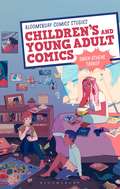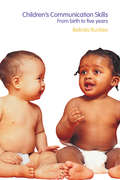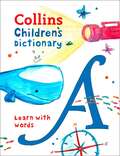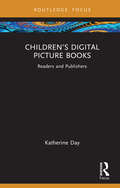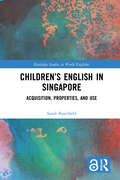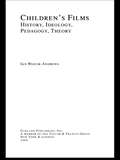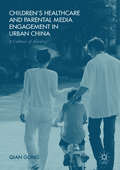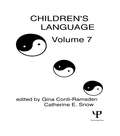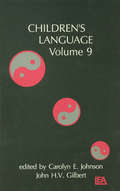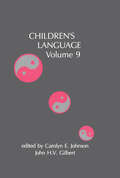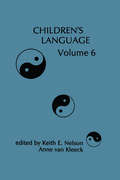- Table View
- List View
Children's and Young Adult Comics (Bloomsbury Comics Studies)
by Gwen Athene TarboxA complete critical guide to the history, form and contexts of the genre, Children's and Young Adult Comics helps readers explore how comics have engaged with one of their most crucial audiences. In an accessible and easy-to-navigate format, the book covers such topics as: - The history of comics for children and young adults, from early cartoon strips to the rise of comics as mainstream children's literature - Cultural contexts – from the Comics Code Authority to graphic novel adaptations of popular children's texts such as Neil Gaiman's Coraline - Key texts – from familiar favourites like Peanuts and Archie Comics to YA graphic novels such as Gene Luen Yang's American Born Chinese and hybrid works including the Diary of a Wimpy Kid series - Important theoretical and critical approaches to studying children's and young adult comics Children's and Young Adult Comics includes a glossary of crucial critical terms and a lengthy resources section to help students and readers develop their understanding of these genres and pursue independent study.
Children's books, brain development, and language acquisition (ISSN)
by Ralf ThiedeThis book correlates English-speaking children’s brain development and acquisition of language with the linguistic input that comes from children’s books. Drawing from the most current research on the developing brain, the author demonstrates how language acquisition is exclusively interactive, and highlights the benefit that accrues when that interaction includes the exploratory language play found in early childhood literature. Through discussions of specific domains of grammar, the relation of these domains to children’s literature through scaffolding, and the resultant linguistic and cognitive advantages for the child, this volume offers an innovative approach to early brain maturation.
Children's books, brain development, and language acquisition (ISSN)
by Ralf ThiedeThis book correlates English-speaking children’s brain development and acquisition of language with the linguistic input that comes from children’s books. Drawing from the most current research on the developing brain, the author demonstrates how language acquisition is exclusively interactive, and highlights the benefit that accrues when that interaction includes the exploratory language play found in early childhood literature. Through discussions of specific domains of grammar, the relation of these domains to children’s literature through scaffolding, and the resultant linguistic and cognitive advantages for the child, this volume offers an innovative approach to early brain maturation.
Children's Books for Grown-Up Teachers: Reading and Writing Curriculum Theory (Studies in Curriculum Theory Series)
by Peter AppelbaumTeachers and prospective teachers read children's books, but that reading is often done as a "teacher" – that is, as planning for instruction – rather than as a "reader" engaged with the text. Children’s Books for Grown-Up Teachers models the kind of thinking about teaching and learning – the sort of curriculum theorizing – accomplished through teachers’ interactions with the everyday materials of teaching. It starts with children’s books, branches out into other youth culture texts, and subsequently to thinking about everyday life itself. Texts of curriculum theory describe infrastructures that support the crafts of inquiry and learning, and introduce a new vocabulary of poaching, weirding, dark matter, and jazz. At the heart of this book is a method of reading; Each reader pulls idiosyncratic concepts from children’s books and from everyday life. Weaving these concepts into a discourse of curriculum theory is what makes the difference between "going through the motions of teaching" and "designing educational experiences. This book was awarded the 2009 AERA Division B (Curriculum Studies) Outstanding Book Award.
Children's Books for Grown-Up Teachers: Reading and Writing Curriculum Theory (Studies in Curriculum Theory Series)
by Peter AppelbaumTeachers and prospective teachers read children's books, but that reading is often done as a "teacher" – that is, as planning for instruction – rather than as a "reader" engaged with the text. Children’s Books for Grown-Up Teachers models the kind of thinking about teaching and learning – the sort of curriculum theorizing – accomplished through teachers’ interactions with the everyday materials of teaching. It starts with children’s books, branches out into other youth culture texts, and subsequently to thinking about everyday life itself. Texts of curriculum theory describe infrastructures that support the crafts of inquiry and learning, and introduce a new vocabulary of poaching, weirding, dark matter, and jazz. At the heart of this book is a method of reading; Each reader pulls idiosyncratic concepts from children’s books and from everyday life. Weaving these concepts into a discourse of curriculum theory is what makes the difference between "going through the motions of teaching" and "designing educational experiences. This book was awarded the 2009 AERA Division B (Curriculum Studies) Outstanding Book Award.
Children's Communication Skills: From Birth to Five Years
by Belinda BuckleyBased on a huge body of research in child language and communication development, Children's Communication Skills uses a clear format to set out the key stages of communication development in babies and young children. Its aim is to increase awareness in professionals working with children of what constitutes human communication and what communication skills to expect at any given stage. Illustrated throughout with real-life examples, this informative text addresses: normal development of verbal and non-verbal communication skills the importance of play in developing these skills developmental communication problems bilingualism, cognition and early literacy development working with parents of children with communication difficulties. Features designed to make the book an easy source of reference include chapter summaries, age-specific skills tables, sections on warning signs that further help may be needed, and a glossary of key terms. It will be of great use to a wide range of professionals in training or working in health, education and social care.
Children's Communication Skills: From Birth to Five Years
by Belinda BuckleyBased on a huge body of research in child language and communication development, Children's Communication Skills uses a clear format to set out the key stages of communication development in babies and young children. Its aim is to increase awareness in professionals working with children of what constitutes human communication and what communication skills to expect at any given stage. Illustrated throughout with real-life examples, this informative text addresses: normal development of verbal and non-verbal communication skills the importance of play in developing these skills developmental communication problems bilingualism, cognition and early literacy development working with parents of children with communication difficulties. Features designed to make the book an easy source of reference include chapter summaries, age-specific skills tables, sections on warning signs that further help may be needed, and a glossary of key terms. It will be of great use to a wide range of professionals in training or working in health, education and social care.
Children's Dictionary: Illustrated Dictionary For Ages 7+ (Collins Children's Dictionaries)
by Collins Dictionaries Maria Herbert-LiewChildren’s Digital Picture Books: Readers and Publishers
by Katherine DayDuring the COVID-19 pandemic lockdowns, children’s media use increased (Mesce et al. 2021) while a decrease in print-book reading was observed (Nolan et al. 2022). An increase in tablet use suggests that when children were reading, it was mostly online in the form of ePub3 pdf files for illustrated works and prescribed school texts, while smartphone use was linked to apps and games. (Susilowati et al. 2021) For many years now, children’s publishers have experimented with digital picture-book formats but have regarded the genre as not suitable for digitisation.This book documents the findings of a one-year research project engaging the children’s publishing sector for feedback on reading trends and digital publishing in picture-book genres. The research assesses the plight of picture books in the current climate and considers how picture-book publishers cater to diverse readerships and new reading platforms post Covid-19 lockdowns and into the digital age.Written by an academic and editor with over 15 years industry experience, this book offers a nuanced response to children’s picture book publishing and reception for librarians, teachers, publishers and international scholars in the fields of publishing studies, library studies, early childhood studies, early education and childhood psychology.
Children’s Digital Picture Books: Readers and Publishers
by Katherine DayDuring the COVID-19 pandemic lockdowns, children’s media use increased (Mesce et al. 2021) while a decrease in print-book reading was observed (Nolan et al. 2022). An increase in tablet use suggests that when children were reading, it was mostly online in the form of ePub3 pdf files for illustrated works and prescribed school texts, while smartphone use was linked to apps and games. (Susilowati et al. 2021) For many years now, children’s publishers have experimented with digital picture-book formats but have regarded the genre as not suitable for digitisation.This book documents the findings of a one-year research project engaging the children’s publishing sector for feedback on reading trends and digital publishing in picture-book genres. The research assesses the plight of picture books in the current climate and considers how picture-book publishers cater to diverse readerships and new reading platforms post Covid-19 lockdowns and into the digital age.Written by an academic and editor with over 15 years industry experience, this book offers a nuanced response to children’s picture book publishing and reception for librarians, teachers, publishers and international scholars in the fields of publishing studies, library studies, early childhood studies, early education and childhood psychology.
Children’s Drawings: Iconic Coding of the Environment (Topics in Contemporary Semiotics)
by Martin KrampenThis book is dedicated to all those who love children and their wonderful, often surprising, drawings. This means it addresses all those interested in their devel oping capacity to produce "iconic" signs: parents, teachers, child psychologists, artists, architects (since building drawings are treated here), and semioticians at large-to name but a few potential readers. Because of the broad audience, I tried to keep scientific jargon to a minimum. Whenever this was unavoidable, I tried to explain the terms in such a way that even beginners in psychology could understand my arguments. I received the first impulse to think about a book like this from the Interna tional Year of the Child declared by the UN in 1979. In a first phase of the project, I obtained drawings of the six different building types treated in this book from more than 100 children aged 3-12 years in Turkey during a stay there as part of the faculty of Architecture of the Karadeniz Technical University in Trabzon under the auspices of the UN ESCO/UNDP program TUR/75/012. My special thanks go to Dr. Erdem Aksoy, then president of the university, and Dr. Ozgontil Aksoy, then dean of the faculty of Architecture and Civil Engineering, for their encouragement to carry out the project. I would also like to thank Dr. Kutzal Oztlirk, Sevinc Erttirk, Ali Ozbilen, Hasan Saltik, together with all the teachers in nursery and elementary schools in and around Trabzon who helped to collect the drawings.
Children's Early Text Construction
by Clotilde Pontecorvo Margherita Orsolini Barbara Burge Lauren B. ResnickFor decades, research on children's literacy has been dominated by questions of how children learn to read. Especially among Anglophone scholars, cognitive and psycholinguistic research on reading has been the only approach to studying written language education. Echoing this, debates on methods of teaching children to read have long dominated the educational scene. This book presents an alternative view. In recent years, writing has emerged as a central aspect of becoming literate. Research in cognitive psychology has shown that writing is a highly complex activity involving a degree of planning unknown in everyday conversational uses of language. At the same time, developmental studies have revealed that when young children are asked to "write," they show a surprisingly sophisticated understanding of the representational constraints of alphabetic writing systems. They show this understanding long before they can read conventional writing on their own. The rich structure of meanings involved in the word text provided the glue that brought together a group of scholars from several disciplines in an international workshop held in Rome. Reflecting the state of the field at the time, the majority of the workshop participants were scholars working in languages other than English, especially the romance languages. Their work mirrors a linguistic and psychological research tradition that Anglophone scholars knew little of until recently. This volume provides English-language readers with updated versions of the papers presented at the meeting. The topics discussed at the workshop are represented in the chapters as follows: * the relationship between acquisition of language and familiarity with written texts; * the reciprocal "permeability" between spoken and written language; * the initial phases of text construction by children; and * the educational conditions that facilitate written language acquisition and writing practice.
Children's Early Text Construction
by Clotilde Pontecorvo Margherita Orsolini Barbara Burge Lauren B. ResnickFor decades, research on children's literacy has been dominated by questions of how children learn to read. Especially among Anglophone scholars, cognitive and psycholinguistic research on reading has been the only approach to studying written language education. Echoing this, debates on methods of teaching children to read have long dominated the educational scene. This book presents an alternative view. In recent years, writing has emerged as a central aspect of becoming literate. Research in cognitive psychology has shown that writing is a highly complex activity involving a degree of planning unknown in everyday conversational uses of language. At the same time, developmental studies have revealed that when young children are asked to "write," they show a surprisingly sophisticated understanding of the representational constraints of alphabetic writing systems. They show this understanding long before they can read conventional writing on their own. The rich structure of meanings involved in the word text provided the glue that brought together a group of scholars from several disciplines in an international workshop held in Rome. Reflecting the state of the field at the time, the majority of the workshop participants were scholars working in languages other than English, especially the romance languages. Their work mirrors a linguistic and psychological research tradition that Anglophone scholars knew little of until recently. This volume provides English-language readers with updated versions of the papers presented at the meeting. The topics discussed at the workshop are represented in the chapters as follows: * the relationship between acquisition of language and familiarity with written texts; * the reciprocal "permeability" between spoken and written language; * the initial phases of text construction by children; and * the educational conditions that facilitate written language acquisition and writing practice.
Children’s English in Singapore: Acquisition, Properties, and Use (Routledge Studies in World Englishes)
by Sarah BuschfeldCombining the World Englishes framework with First Language Acquisition methodology, this book investigates children’s acquisition of L1 English in the context of multilingual Singapore, one of the traditional Kachruvian Outer Circle or ESL countries. The book investigates language choice, use, and dominance in Singaporean families, identifies common linguistic characteristics of L1 Singapore English, as well as the acquisitional route that Singaporean children take. It discusses characteristics at the different levels of language organization, i.e., phonological, morphosyntactic, lexical, and pragmatic features, drawing on a variety of systematically elicited data and Praat-based acoustic analyses. Comparing the results to similar data obtained from children living in England (both mono- and bi-/multilingual), the book also sheds light on how the acquisitional steps taken by Singaporean children differ from or are similar to traditional native speakers of English and children from immigrant families in England.
Children’s English in Singapore: Acquisition, Properties, and Use (Routledge Studies in World Englishes)
by Sarah BuschfeldCombining the World Englishes framework with First Language Acquisition methodology, this book investigates children’s acquisition of L1 English in the context of multilingual Singapore, one of the traditional Kachruvian Outer Circle or ESL countries. The book investigates language choice, use, and dominance in Singaporean families, identifies common linguistic characteristics of L1 Singapore English, as well as the acquisitional route that Singaporean children take. It discusses characteristics at the different levels of language organization, i.e., phonological, morphosyntactic, lexical, and pragmatic features, drawing on a variety of systematically elicited data and Praat-based acoustic analyses. Comparing the results to similar data obtained from children living in England (both mono- and bi-/multilingual), the book also sheds light on how the acquisitional steps taken by Singaporean children differ from or are similar to traditional native speakers of English and children from immigrant families in England.
Children's Films: History, Ideology, Pedagogy, Theory (Children's Literature and Culture)
by Ian Wojik-AndrewsThis study examines children's films from various critical perspectives, including those provided by classical and current film theory.
Children's Films: History, Ideology, Pedagogy, Theory (Children's Literature and Culture)
by Ian Wojik-AndrewsThis study examines children's films from various critical perspectives, including those provided by classical and current film theory.
Children’s Healthcare and Parental Media Engagement in Urban China: A Culture of Anxiety?
by Qian GongThis book analyses parental anxieties about their children’s healthcare issues in urban China, engaging with wider theoretical debates about modernity, risk and anxiety. It examines the broader social, cultural and historical contexts of parental anxiety by analysing a series of socio-economic changes and population policy changes in post-reform China that contextualise parental experiences. Drawing on Wilkinson’s (2001) conceptualisation linking individual’s risk consciousness to anxiety, this book analyses the situated risk experiences of parents’ and grandparents’, looking particularly into their engagement with various types of media. It studies the representations of health issues and health-related risks in a parenting magazine, popular newspapers, commercial advertising and new media, as well as parents’ and grandparents’ engagement with and response to these media representations. By investigating ‘a culture of anxiety’ among parents and grandparents in contemporary China, this book seeks to add to the scholarship of contemporary parenthood in a non- Western context.
Children’s Knowledge-in-Interaction: Studies in Conversation Analysis
by Amanda Bateman Amelia ChurchThis book is a collected volume that brings together research from authors working in cross-disciplinary academic areas including early childhood, linguistics and education, and draws on the shared interests of the authors, namely understanding children’s interactions and the co-production of knowledge in everyday communication. The collection of studies explores children’s interactions with teachers, families and peers, showing how knowledge and learning are co-created, constructed and evident in everyday experiences.
Children's Language: Consensus and Controversy
by Ray CattellThe popular notion of how children come to speak their first language is that their parents teach them words, then phrases, then sentences, then longer utterances. Although there is widespread agreement amongst linguists that this account is wrong, there is much less agreement as to how children really learn language. This revised edition of Ray Cattell's bestselling textbook aims to give readers the background necessary to form their own views on the debate, and includes accessible summaries of key thinkers, including Chomsky, Halliday, Karmiloff-Smith and Piaget.
Children's Language: Volume 7 (Children's Language Series)
by Gina Conti-Ramsden Catherine E. SnowThis volume presents current research findings on vital issues in language development compiled by an international group of leading researchers. The data are drawn from studies of the acquisition of Swedish, Polish, Serbo-Croatian, Hungarian, Portuguese, Italian, and English. Themes emphasized in all the chapters include the importance of the social context of acquisition, the existence of interconnections among various domains of language development, and the impossibility of understanding acquisition using a simple theory or a single methodological approach.
Children's Language: Volume 7 (Children's Language Series)
by Gina Conti-Ramsden Catherine E. SnowThis volume presents current research findings on vital issues in language development compiled by an international group of leading researchers. The data are drawn from studies of the acquisition of Swedish, Polish, Serbo-Croatian, Hungarian, Portuguese, Italian, and English. Themes emphasized in all the chapters include the importance of the social context of acquisition, the existence of interconnections among various domains of language development, and the impossibility of understanding acquisition using a simple theory or a single methodological approach.
Children's Language: Volume 9 (Children's Language Series)
by John H. V. Gilbert Carolyn E. JohnsonThis volume brings together the work of 32 scholars from 13 countries -- investigations of children learning 15 different languages, in some instances more than one at a time. The scope of this work -- as broad as it is -- only partially represents the research interests and approaches of the more than 350 scholars from 34 countries who contributed papers or posters to the Sixth International Congress for the Study of Child Language. This investigative power and diversity are, for the most part, focused on topics and issues of modern day child language research that have been under discussion for the last 30 years or so. Some even go beyond that in early diary studies and philosophers' speculations. While the issues are mainly familiar ones, the 17 chapters contribute to the advancement of child language study in several specific ways. They: * represent current theoretical frameworks, both bringing the insights of the theories to the interpretation of language development and testing tenets or implications of the theories with child language data; * contribute substantively to the crosslinguistic study of child language, reflecting both the linguistic diversity of the authors themselves and a recent major shift in the approach to child language study; * build on the now considerable body of knowledge about children's language, both adding to information about the basic systems of phonology, syntax, and semantics, and extending beyond to explore aspects of narrative and literacy development, language acquisition by bilingual and atypical children, and language processing; and * contain hints of new directions in child language study, such as increased attention to the impact of phonology on other language systems. Taken as a whole, this volume reflects the current strength of crosslinguistic research, the application and testing of new theoretical developments, a new legitimacy of language disorder data, and a new appeal to the descriptive possibilities of language processing models. In addition, there is a theme that runs through many of the chapters and points the way for important research in the future: the role of prosody in the acquisition of various language structures and systems.
Children's Language: Volume 9 (Children's Language Series)
by Carolyn E. Johnson John H. V. GilbertThis volume brings together the work of 32 scholars from 13 countries -- investigations of children learning 15 different languages, in some instances more than one at a time. The scope of this work -- as broad as it is -- only partially represents the research interests and approaches of the more than 350 scholars from 34 countries who contributed papers or posters to the Sixth International Congress for the Study of Child Language. This investigative power and diversity are, for the most part, focused on topics and issues of modern day child language research that have been under discussion for the last 30 years or so. Some even go beyond that in early diary studies and philosophers' speculations. While the issues are mainly familiar ones, the 17 chapters contribute to the advancement of child language study in several specific ways. They: * represent current theoretical frameworks, both bringing the insights of the theories to the interpretation of language development and testing tenets or implications of the theories with child language data; * contribute substantively to the crosslinguistic study of child language, reflecting both the linguistic diversity of the authors themselves and a recent major shift in the approach to child language study; * build on the now considerable body of knowledge about children's language, both adding to information about the basic systems of phonology, syntax, and semantics, and extending beyond to explore aspects of narrative and literacy development, language acquisition by bilingual and atypical children, and language processing; and * contain hints of new directions in child language study, such as increased attention to the impact of phonology on other language systems. Taken as a whole, this volume reflects the current strength of crosslinguistic research, the application and testing of new theoretical developments, a new legitimacy of language disorder data, and a new appeal to the descriptive possibilities of language processing models. In addition, there is a theme that runs through many of the chapters and points the way for important research in the future: the role of prosody in the acquisition of various language structures and systems.
Children's Language: Volume 6 (Children's Language Series)
by Keith E. Nelson; Anne van KleeckThis series, Children’s Language, reflects the conviction that extensive work on entirely new fronts along with a great deal of reinterpretation of old-front data will be necessary before any persuasive and truly orderly account of language development can be assembled. None of the chapters are simply reviews, and none of the volumes are " handbooks" or " reviews" or introductory texts. Rather the volumes try to capture the excitement and complexity of thinking and research at the growing, advancing edges of this broad field of children’s language. In line with these goals for the Children’s Language series the present volume includes coverage of a fairly wide range of topics and subtopics. The authors for each chapter will weave their own story and we leave to them the introduction of their main plots and the major and minor characters in their scientific stories. This is volume 6.
